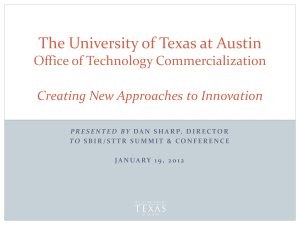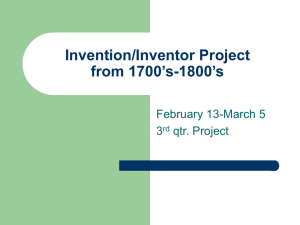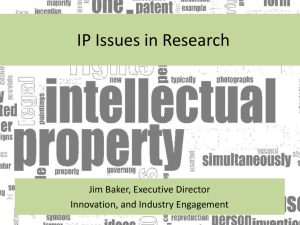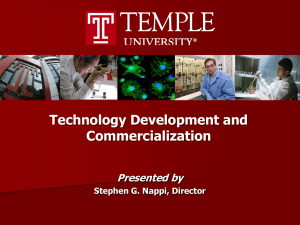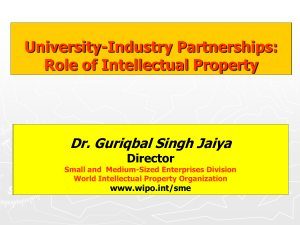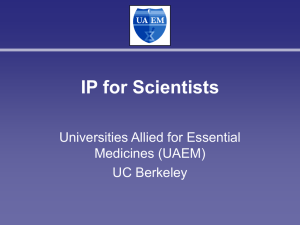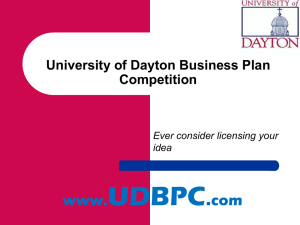PowerPoint Presentation - Off
advertisement
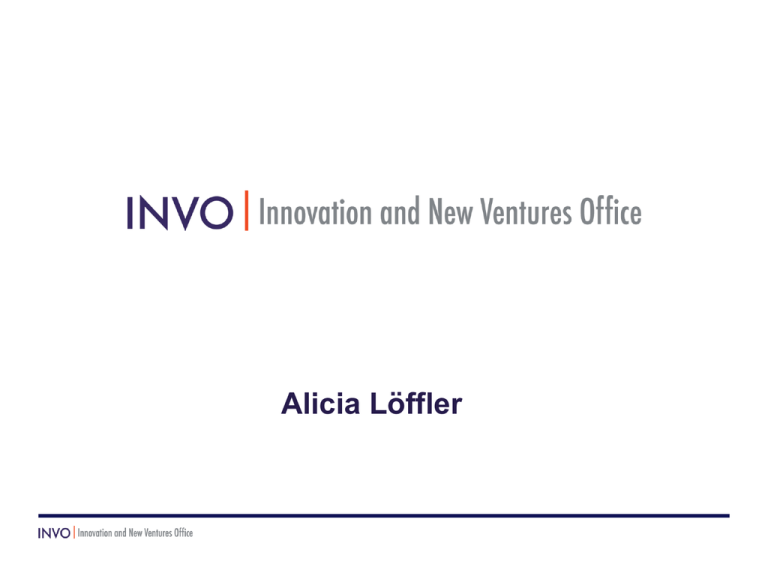
Alicia Löffler Northwestern is at an Inflection Point Extraordinary Faculty First IPO Alumni Success Highest Licensing Revenues Invention is serendipitous Innovation is not “It is an organization-wide effort that requires infrastructure and discipline and impacts how Northwestern University behaves within & with the world around” Inspire a culture of innovation that bridges research and its practical use for public benefit. Many Ways to Bridge the Gap Between Research and Practical Use RESEARCH START-UP LICENSE TO CORPORATIONS NEW PRODUCTS FOR THE PUBLIC Students Publications Seminars, conferences, etc. Faculty consulting Industry sponsored research Industrial affiliate programs Commercialization: Intellectual Property, licensing, start-up What Keeps Us Moving in the Morning? Treating millions of patients around the globe with fibromyalgia, pain associated with diabetes shingles, and epilepsy Initial patent 1989 Licensed to Parke-Davis 1990 NIH ABO- Early detection of colon (and other) cancers – Will save millions of lives 2006 Developed in collaboration with industry NIH and NSF Wildcat System - HIV testing in remote and resource-poor areas of the world - predicted to save 4 million lives in Africa/year Developed in collaboration with Industry 2006 Bill and Melinda Gates Foundation Process of Innovation Fundamentally Changed in the Last Twenty Years Government Academia Industry Innovations Academia Government Innovations © Kellogg School of Management The structure of innovation and commercialization today is so interwoven that it is difficult to delineate government, academic from commercial institutions NIH The US Position in Innovation Fueled by Cornerstone Policies 1978-80 VC --Reagan’s Pension Funds Patents - The Supreme Court's Diamond vs. Chakrabarty decision, allowed recombinant organisms Bayh-Dole Act of 1984, helped move federally funded discoveries off the shelf and into private development. Balance innovation incentives with access of innovation to the public Bayh Dole Act Allows: US Universities to have IP control of their inventions that resulted from Federal Government Grants US Universities to grant exclusive licenses in the technologies to private companies. Restrictions: Universities must share proceeds with inventors. Reserves to the government a royalty-free non-exclusive license to use the invention for government purposes. Bayh- Dole gives the government so-called "march-in rights" which enable it to compel licensing of a federally funded invention if the patent owner has not commercialized the invention in a reasonable time or makes the product not accessible to the public US Patent Activity from Academia 20,000 18,000 16,000 Total Patent Applications 14,000 12,000 10,000 8,000 New Patent Applications 6,000 4,000 2,000 Issued Patents 1991199219931994199519961997199819992000200120022003200420052006200720082009 11 Licensing Income $3,500 $3,000 Licensing Income ($ million) Total Income $2,500 $2,000 $1,500 $1,000 Running Royalties All Other $500 Sale of Stock $0 Year 12 Start-Ups Formed 900 800 Number of Start-Ups Formed 700 600 500 400 300 200 100 - Year 13 University Start-Up Companies 7,251 start ups formed 1980-2009 279,000 jobs created since 1996 $187 billion added to U.S. GDP 72% located in same state as institution Every state except Alaska 12.3% from California institutions 11.8% from Massachusetts institutions 363 by MIT 349 by University of California System 175 by University of Utah 34 by Northwestern University 14 Process Expanded Purpose of the Function: From Linear to Multidimensional Transactional Business Development To Comprehensive, Open, and Pro-active Faculty Outreach & Translation Chemical, Pharmaceutical, Medical Device, Diagnostic Company Advisors Disclosure Patentability Patent Auction, trade, bundle, etc Commercialization Plan Business/ Financing Plan Angel and Investor Advisors Market and Licensing Start-up Faculty Outreach Innovation Mentors Program Commercialization Clinics DISCLOSURE Creates important documentation: a record of the invention identifies the inventor(s) involved identifies who sponsored the work lists public disclosures and publications First to Invent vs. First to File (soon to change) Disclosure: Back-office Considerations Discuss with inventors Inventor provides technical expertise Inventor may also provide industry contacts Contact industry experts Consult with legal experts Internal analysis Cross check sponsored work Report to government Determine inventor’s “home” Determine previous commitments made Typical criteria Prior art Invention development status Intellectual property position Enforceability Commercial potential Licensing potential PATENT Exclusive rights granted for a limited period of time in exchange for a disclosure of an invention. Must be new, useful and non-obvious. Why Patent? Required by investors and commercial developers to justify investments Only currency for startups Positions faculty for further funding Facilitates exchange of knowledge, promote disclosure rather than secrecy Adds clarity to agreements and partnerships Patent decisions are often driven by publication (usually too early) Patents: Back-office Considerations Licensing associates manage the process Technology and commercial expertise Responsible for invention from cradle to license Very resource intensive (money/skills/time) Patent costs Typically $25,000 to $35,000 over life of U.S. patent USPTO (US Patent and Trademark Office) fees Patent attorney/agent costs Higher patent costs for foreign coverage PCT (Patent Cooperation Treaty) application preserves foreign rights while delaying costs COMMERCIALIZATION PLAN Plan to determine best path to bring the technology to society License to operational company License to startup Commercialization Plan Discuss with inventors Inventor may also provide industry contacts Inventor’s preference (startup or license?) Typical criteria Contact industry experts Consult with investors Match Faculty with entrepreneurs Develop Marketing Plans (with Kellogg students) Market and “promote” technologies Technical Risk Market Risk Financial Risk Regulatory Risk Management Capabilties Licensing potential LICENSE An agreement where the owner of intellectual property gives permission to allow another party to act under all or some of the owner’s rights to further develop the technology Licensing: Back Office Considerations IP Rights Licensor Northwestern University Licensee Development Organization Complex agreements, covering decades Different inventions, different strategies Many ways to negotiate, approach to terms. Emotional Licenses NEVER die. They accumulate through decades. Renegotiations are the norm. About 200 active licenses Northwestern’s Distribution Policy Net Royalties = Cash Royalties minus 20% for legal and administrative expenses inventor's research 20 35 inventor Department School or Center 30 5 10 Central Facts The People PARTNERS AND ADVISORS 4 ADMINISTRATORS 12 investor advisors from VC firms in the country Two external early stage VC firms Finance Databases Government compliance 7 LICENSING MANAGERS 2 BUSINESS DEVELOPMENT MANAGERS Strong technical background, PhDs Conduct due diligence Manage invention from cradle to license Manage outside counsel Market technologies Commercial and Start-up experience Work with licensing managers and inventors to determine commercialization path 30-35 STUDENTS Vital Signs 2010 200 inventions/year, 75% biomedical 58 issued patents 6 start-ups (5 biomedical) Licensing revenues of $180 million 222 active licenses Northwestern University Licensing Revenues are the Highest in the Nation Followed by Columbia, MIT, Rochester, Stanford and Harvard Northwestern University Licensing Revenues have been ranked the Highest in the Nation (last survey released Dec. 2010) Northwestern University Royalty Revenues 900,000,000 800,000,000 700,000,000 600,000,000 500,000,000 400,000,000 300,000,000 200,000,000 100,000,000 0 2005 2006 2007 2008 2009 2010 Invention Disclosures per School Six month report July thru December 2010 Total 103 inventions 20% 28% Feinberg School of Medicine McCormick School of Engineering 52% Weinberg College of Arts and Sciences Invention Disclosures by Department Six month report July thru December 2010 McCormick Biomedical Engineering 5% Chemical and Biological Engineering 29% 22% Civil and Environmental Engineering Electrical Engineering and Computer Science Industrial Engineering and Management Sciences 2% 16% Materials Science and Engineering 24% Mechanical Engineering 2% Invention Disclosures by Department Six month report July thru December 2010 Weinberg College of Arts and Sciences 5% Chemistry Neurobiology and Physiology 95% Invention Disclosures by Department Six Month Report July thru December 2010 Feinberg School of Medicine Cell and Molecular Biology Medicine 7% 17% Microbiology/Immunology Neurology 24% Obstetrics and Gynecology 14% Physical Medicine and Rehabilitation Physiology 4% 7% Radiology 3% 7% 14% 3% Surgery Urology Start-ups by School 25 20 15 10 5 0 MEAS WCAS FSM Potential profit is not a driver to bring research to the market: It is a numbers game. Research Disclosure Patents Profits License 15 – 20 Years $1 – 3B Research Funding 1000 disclosures 500 patents 150 licenses 15 start-ups 1 -2 licenses will generate $1M 1 IPO Such long time lines make it almost impossible to pick winners Evolving Towards a Translational Culture Description Programs Celebrate Role Models FACULTY Identify serial inventors Celebrate success. Make “heroes” out of entrepreneurs Annual Award Articles in internal & external publications Catalyze Change STUDENTS Use students as agents of change Leverage students talents to “walk the halls” and help with commercialization NUvention Program I2C (Innovation to Commercialization) Internship Program Develop Know-How FACULTY, STUDENTS. ADMINISTRATORS Programs to educate and empower faculty in commercialization Connect faculty with outside knowledge Commercialization Clinics Faculty Lunches and Seminars CIM Mentorship Program Role Modeling Flawless, Efficient, Supportive Infrastructure Efficient, lean, holistic, process and Policies ADMINISTRATION Developmental Therapeutics Program Implement Knowledge systems Process Engineering Language for Promotion & Tenure Decisions Good luck!! THANK YOU…..

